Many of us despise the disastrous effects of barbed wire fences on birds and other wildlife and I share that view. But maybe it’s a more nuanced issue than some of us believe. Could it be that barbed wire fences have a more positive overall effect on some species than negative?
The example I’ll use will be the Short-eared Owl (SEO), though a similar argument could be made for several raptor species. Regular readers know that I’ve documented two SEO’s, a Barn Owl, a Burrowing Owl and even bats that have been killed or injured when they flew into and became entangled in barbed wire. When I encounter situations like that, believe me it becomes very, very personal – especially when the victim is still alive and struggling. My knee-jerk reaction is to categorize barbed wire fences with left-over land mines, assault rifles in the hands of lunatics, freeways in wild areas without wildlife overpasses and oil companies drilling in pristine places. Ban’em all!
But maybe it’s more complicated than that. After all, barbed wire fences have two primary components – strands of barbed wire and the posts that support them. For me the barbed wire itself is an anathema, a contraption of the (metaphorical) devil that causes immense pain and suffering in wild and domestic animals (and occasionally people) and has significant and measurable negative environmental consequences.
But the fence posts supporting the devil-wire – they may be another story altogether.
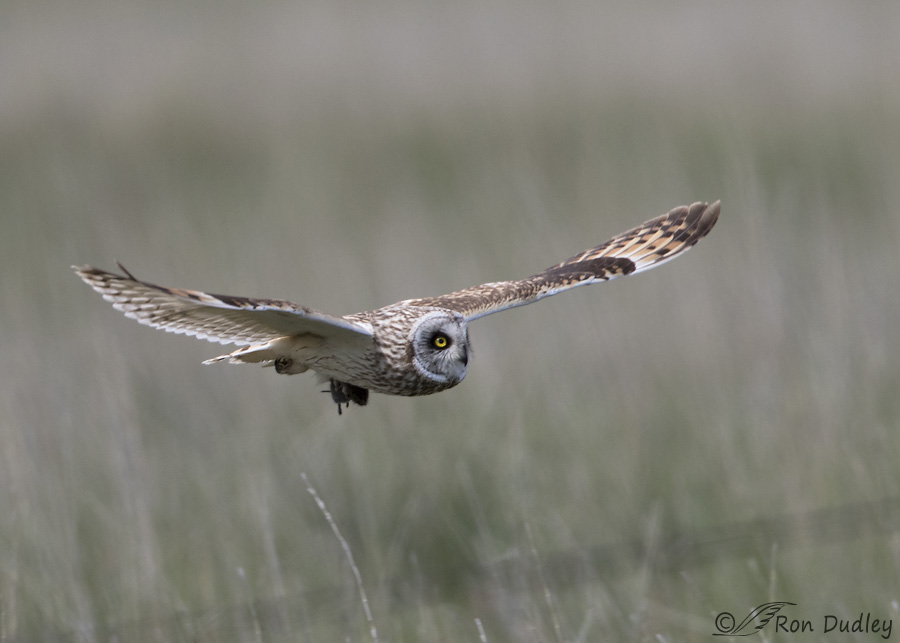
1/1600, f/6.3, ISO 500, Canon 7D Mark II, Canon EF 500mm f/4L IS II USM + EF 1.4 III Extender, not baited, set up or called in
Short-eared Owls use fence posts for so many of their daily activities that I almost think of the posts as SEO security blankets. This owl has just caught a vole and where do you think it’s going to securely enjoy its meal? (sharp-eyed readers will see a hint to the answer in the photo)
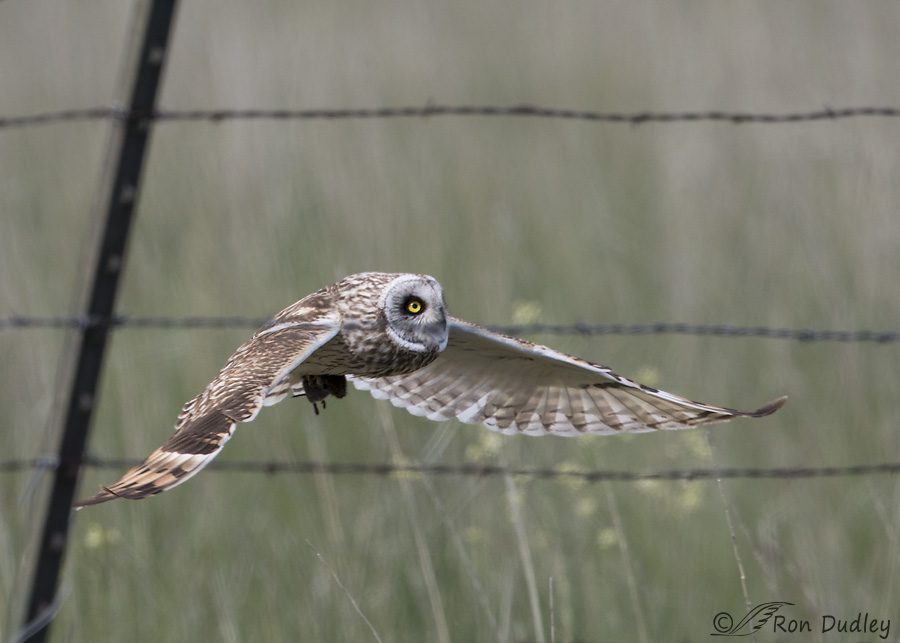
1/1250, f/6.3, ISO 500, Canon 7D Mark II, Canon EF 500mm f/4L IS II USM + EF 1.4 III Extender, not baited, set up or called in
Yup, it’s about to land on one of the metal posts supporting the barbed wire and that’s where it ate the vole. I see this happening again and again with SEO’s when posts are available. Those damned wires ruin a lot of my photos but SEO’s sure love the posts that support them.
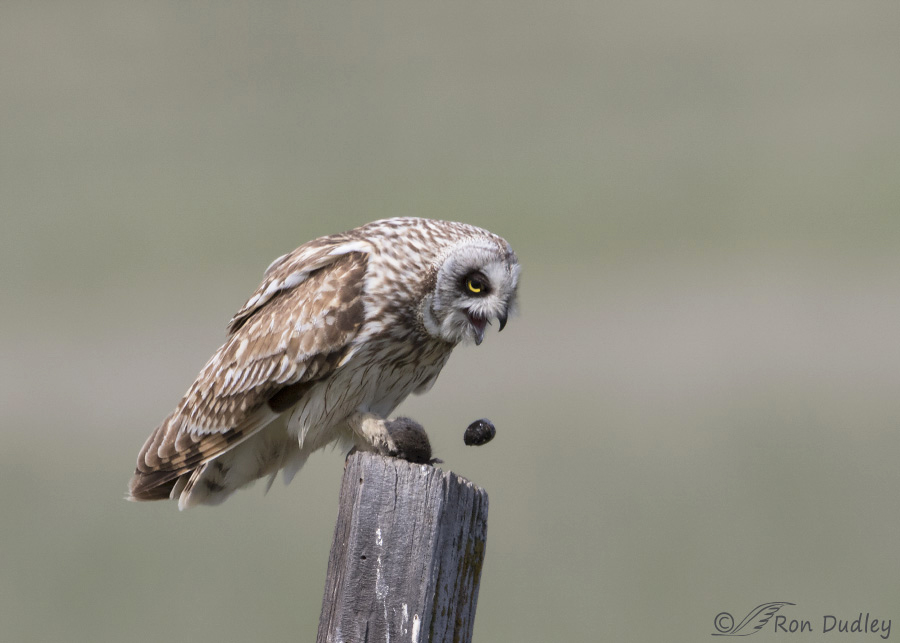
1/1600, f/7.1, ISO 500, Canon 7D Mark II, Canon EF 500mm f/4L IS II USM + EF 1.4 III Extender, not baited, set up or called in
Many wooden posts have a larger surface on top that provides more stable support and effectively becomes their dining room table. This owl had to cough up a pellet before eating to make room for the vole.
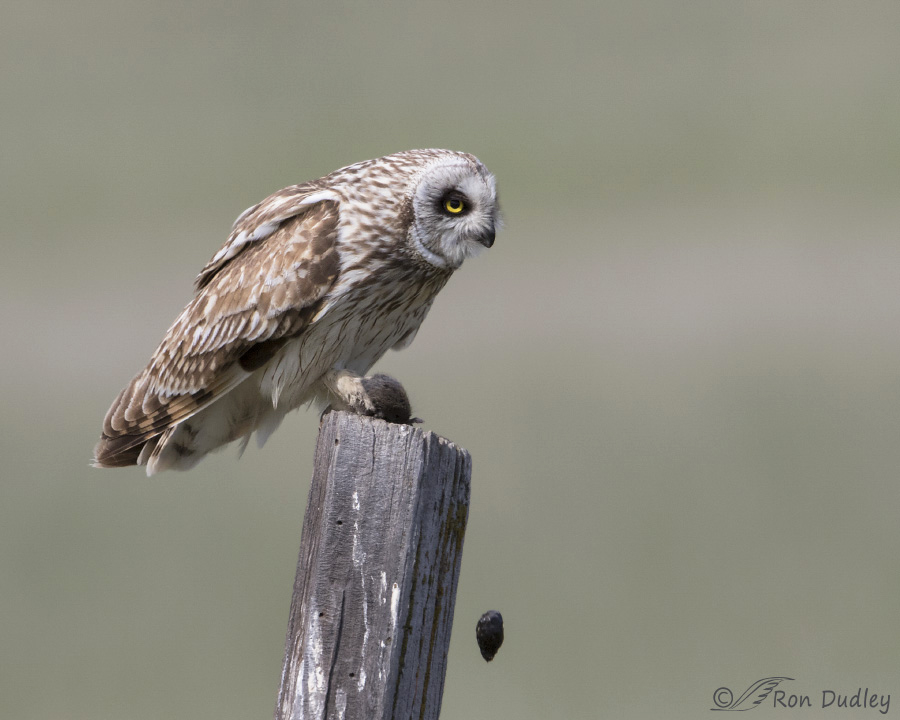
1/1600, f/7.1, ISO 500, Canon 7D Mark II, Canon EF 500mm f/4L IS II USM + EF 1.4 III Extender, not baited, set up or called in
After the pellet fell to the ground the owl enthusiastically gobbled down its rodential meal.
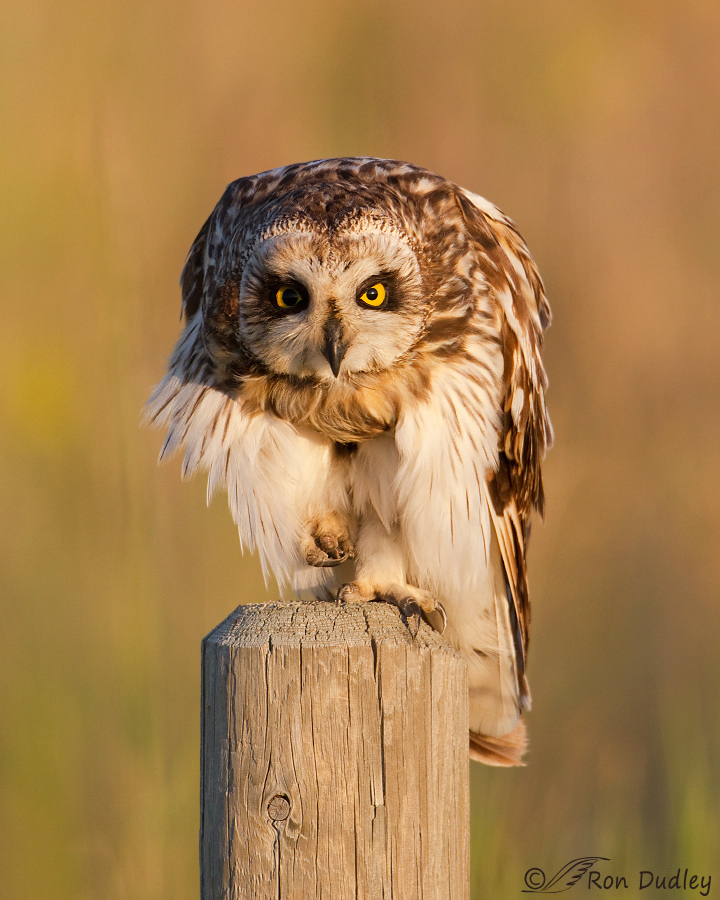
1/500, f/8, ISO 500, Canon 7D, Canon EF 500mm f/4L IS USM + EF 1.4 II Extender, not baited, set up or called in
SEO’s also use fence posts for many of their other routine activities including resting, grooming and perch-hunting. This Montana bird spent several hours just before dusk on this post as it slept and preened. And during breeding season SEO males often stand guard over their nest (where the female would be with eggs or young) by perching on nearby fence posts.
Over the years I’ve spent many hundreds of hours looking for, observing and photographing Short-eared Owls and they naturally seem to gravitate toward fence posts. I think there’s more to it than just the fact that I’m more likely to see them on elevated perches like posts than I am when they’re on the ground. Even in large wild areas like Red Rock Lakes NWR where just about the only fences are on the border of the refuge I see very few owls in the interior where there are no fences nearby. And interestingly they don’t perch on power poles, presumably because they’re too tall. In about nine years I’ve only seen one SEO on a power pole (at Golden Spike National Historic Site) and that pole was significantly shorter than most.
I can’t prove it of course but I suspect it’s very possible that we have more Short-eared Owls because of barbed wire fences than we would without them. The same could be said about Burrowing Owls.
I understand that fences are necessary and for a variety of practical reasons many of them are constructed with wire. Ideally land owners will move to using more barbless wire or wire with fewer barbs. Flagging barbed wire fences also helps to reduce bird mortality, especially with species like Sage Grouse.
There’s been a lot of buzz on Feathered Photography about barbed wire fences over the years and it’s my hope that the conversation has contributed to a better understanding of this “thorny” question.
Ron
PS – There’s a lot to read here. If it was too much for you at this early hour of the morning I hope you at least enjoyed some of the photos with your coffee…



I enjoyed it all, especially the wonderful, wonderful owl photos.
Marvelous shots Ron!
Charlotte
Thanks, Charlotte.
Especially love the last shot today. That warm light bathing the shortie and the wonderful background juxtaposed with the shade over part of the owl echoes, to me at least, the complexity of so many issues.
I understand the need for an effective barrier for ranchers. I really do. That being said, scientific and technical knowledge continues over time to provide new solutions. Just as a physician would tend to use the least invasive technique (e.g. arthroscopic vs. open surgery or an MRI vs. an exploratory), so must we all look for less invasive and more humane means to accomplish those necessary tasks.
Okie dokie. Hopping off my soapbox now.
Marty, Here’s hoping they find an alternative soon that works as effectively as barbed wire!
A tad late today, been very busy, but wanted to comment.
Wonderful shots – owls need posts, plus I would think voles would frequent areas around posts. Don’t know why, but I seem to find evidence of voles, at least here in the East, in the vicinity of posts.
I think I understand intellectually why barbed wire was used initially! But, as a people who have graduated into the 21st century, I would think domestic stock could be fenced without barbed wire. I would think that ranchers, farmers, etc. would see the deleterious effect barbed wire has on wildlife. In my mind their use of barbed wire is like saying they don’t care about the wildlife. Yes, I’m not a rancher and therefore do not see in this day and age why barbed wire needs to be used over a fence that has no barbs. Please educate me!
“Please educate me!”
Dick, Here’s my guess. I’ve had some experience with cows and fences and they can be very hard on them – especially yearlings since they’re boisterous, rambunctious and always getting into trouble. Cattle seem determined to go where they’re not supposed to go and they really put fences to the test. Without barbs I can see why ranchers would have more problems containing their stock.
OK, I understand that the barbs help in keeping stock in, but does that mean every wire of the fence needs to be barbed?
Have no quareel with posts…will always hate that effing devil wire they far, far too often support….
I feel the same way, Patty.
Hello Ron, we’ve noted the link at “flagging”, but there is a contradiction as the markers shown in use are not slip resistant attached and will only be useful for VISIBILITY on Barbed Wire, as the “Barbs” act as slip stops. If “Barbless Wire” is used as a top strand, as we advocate to mitigate impact entanglement and you have correctly noted, we would suggest FENCE-FLAGS® for a slip resistant attachment as shown and explained on our web site at http://WWW.FENCE-FLAG.COM. We sure do enjoy your informative blog with comments and photos!!
Don.
Thanks, Frank but I’m not sure why it’s a “contradiction” to refer to using the flags in the link as “flagging”…
And you’re right, I should have mentioned using barbless wire on the top strand in particular, even if barbed wire is used below. That would be particularly helpful with large mammals trying to jump the fences.
It’s NEVER too much to read, especially when the words are so thought provoking!! And paired with such lovely photography, too!
In my dotage, I’ve discovered that there are few (if any) real black-and-white, yes/no answers. Everything is layered and nuanced if you look closely enough and each answer brings up a host of new questions (life was so much simpler when I was 17 and knew everything, but I digress). I certainly agree that without those fence posts for perching, some species just wouldn’t be in that area. It’s argued that redtails, for example, would not be so heavily populated in the west without the advent of the railroads with their attendant telegraph lines that gave them proper hunting perches and allowed them to expand their territories into the Great Plaines and the vast western areas that didn’t have proper hunting perches. And there’s that pesky yin and yang, positive and negative perspective again.
Life on this planet can be so complex, can’t it?
Laura, I also wonder if some songbirds are doing better with fence posts than they would without – Western Meadowlarks come to mind.
And like you, I was a helluva lot smarter in my teens than I am now…
Definitely not too much to read. Seeing what barbwire fences do to birds, like the ones you’ve had to rescue, makes me dislike them. But I also find your theory about having more SEOs because of fences quite interesting – it makes a lot of sense. I would definitely prefer to see ranchers use wire with fewer to no barbs. Love the last shot – it reminds me of the old posters that say “Uncle Sam wants YOU!”
I see EXACTLY what you mean about those old WWII Uncle Sam posters, Susan!
Very much enjoyed this with my coffee. Discovered your site perhaps two weeks ago and have enthusiastically shared many of your posts since. In these current political times when I find “regular” news very unpalatable this has turned into a bright spot in my morning rituals.
Cheers,
Kelly
Welcome aboard, Kelly! I hope you enjoy more posts down the road. And I couldn’t agree with you more about the “unpalatability of these current political times”.
Oh my! That last Shortie is simply spectacular!
Thanks, Diane.
Very educational Ron and appreciated. Love the last photo (as well as the others).
I get the attitude about Barbed wire. It obviously has its purpose. I think mostly it is to keep the live stock “in”, but it causes a lot of frustration to me when I want to “cross the fence” to photograph something that is on the other side. But as I read your post, I also cringed visualizing the memory a fawn trying to get thru the fence after its mother had just jumped. It was not fun to watch. Which brings up the question: Deer always jump, but the prong horns go under. I wonder why the prong horns don’t jump?
Frank, Pronghorn are capable of jumping fences and they do it occasionally. I’ve only seen it once and I thought it was so unusual I immediately walked over to the fence and measured it. It was just over 4 1/2′ tall. But you’re right, they usually go under the fence if they can and very seldom jump them. I don’t know why…
Really liked this perspective. Sometimes really bad things do have silver linings. Gives me hope.
Thank you, Arwen.
I have so many birds where I live. Had a horned owl in my back yard two days ago. But never had the pleasure to see a seo so always enjoy your pictures. Blm has been replacing a lot of barbed wire with very taunt smooth wire. I’m seeing it more and more. It will take years and years to replace all the barb wire but it’s happening. Probably not so much with Ranchers but I am seeing it on BLM lands. Plus the platforms they have erected.
Good to hear what BLM is doing with the wire, Marina. Thanks for the info.
Always seems to be plus/minus to everything! Many birds use the posts for sure. The last shot is REALLY gorgeous.
Many birds use the posts for sure. The last shot is REALLY gorgeous. 
Judy, the owl in that last shot was one of the most cooperative SEO’s I’ve ever photographed. The fact that it was on my Montana family farm made the experience that much more enjoyable.